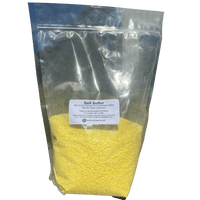It's always recommended to take a soil test before adding sulfur to your lawn or garden. Knowing the pH of your soil is essential to determining the amount of sulfur needed.
When to Apply
It's best to incorporate pelletized sulfur into your soil before plants or grass are in place. If you already have established plants or grass, you can apply sulfur on the soil's surface. In this case, it will take a longer period of time to lower the soil's pH.
Avoid saturating your soil with irrigation water once you've applied soil sulfur, as this will cause the sulfur to be converted to hydrogen sulfide and create a rotten egg smell.
Amount to Apply
If you're unsure how much sulfur to apply to achieve your desired pH level, you can use this sulfur application calculator to give you a better idea. Our soil sulfur bag has a quantity of 8 pounds, or 3.63 kilograms of pelletized soil sulfur.
What is elemental sulfur?
Sulfur is an essential plant nutrient, but it's not uncommon for soil to have a sulfur deficiency and need a nutrient supplement. Some plants (like blueberries) prefer more acidic soils, so supplementing sulfur can help improve their yield.
Adding elemental sulfur to your lawn or garden's sulfur is a low-cost, simple option to lower soil's pH. When sulfur is added to soil, soil biology oxidizes it. This creates sulfuric acid and acidifies your soil, thus lowering the pH.
The process of lowering soil pH through adding sulfur is slow acting. It can take months, but the results are long lasting. The process can be sped up with the addition of microbes with a soil conditioner like Jump Start.
Sulfur Deficiency in Soil
Sulfur is usually present in soil through organic matter. But if the naturally occurring amount of sulfur is insufficient, plants suffer. Adding elemental sulfur can correct a sulfur deficiency.
Changing pH
Adding sulfur to soil creates acid soil conditions, or helps lower pH. Acid soil conditions are desirable when soil is experiencing a deficiency in sulfur, which is an essential plant nutrient. Lower pH levels are also preferable when growing plants that prefer acidic soil, such as azaleas, rhododendrons, camellias, hydrangeas, daffodils, radishes, sweet potatoes, parsley, peppers, potatoes and blueberries.
It's just elemental sulfur! No ingredients here, secret or otherwise.





